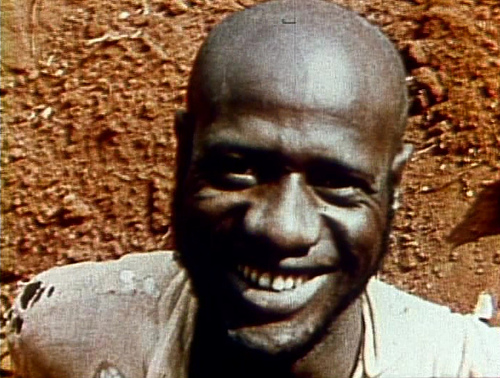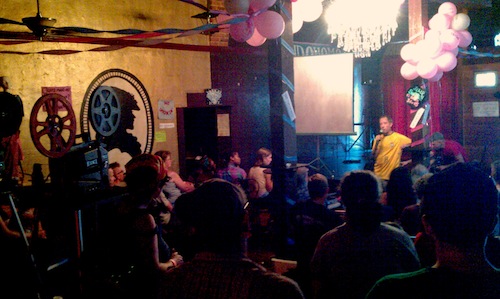On Sunday May 29th, Atlantans witnessed characters become actors, a director become an actress, a young girl become a filmmaker, male become female, an audience become art, a town become possessed, the oppressed become oppressors, and a restaurant become a cinema. These transformations were orchestrated by moving image advocate Andy Ditzler during a ritual he calls Film Love. But Andy's trick is simple. He uses a machine to send light through an image and onto a flat surface, then, at an equal duration, the machine masks the light out. The room transforms from light to dark and it is in this exchange that the audience gathers meaning. "Thus," Amos Vogel explains in his book, Film As A Subversive Art, "during half the time spent at the movies, the viewer sees no picture at all." He goes on to wonder, "could it be precisely during the periods of total darkness -- 45 of every 90 minutes we see -- that our voracious subconscious, newly nourished by yet another provocative image, 'absorbs' the work's deeper meaning and sets off chains of associations?"
Within these exchanges of light and dark, we observed the image of an African man working in a ditch, smiling for the camera. His British occupiers are standing watch nearby. As the shutter closes on this image, our mind expects the next sequential image; instead we see the same man frothing at the mouth, violently shaking, eyes rolled back. Not until the shutter closes again does our mind begin to establish "chains of associations." After a few seconds the man appears once again, standing in a ditch, putting on a smile. The thought is complete: recalling the moment he was possessed within the context of his daily life creates a diagnosis for his symptoms -- that is, he is being oppressed. Suddenly this documentary is transformed from a pedestrian travelogue to sharp comment on the destruction of a culture. We understand his smile is a tool for survival, and it is more grotesque than the frothing, contorted face from before. Presented on 16mm, Jean Rouch's Les Maîtres Fous (The Mad Masters) was a powerful opening to a night of rare and experimental film.
Though not all the movies were shown on film (video has no darkness between frames), all of the films centered around the theme of transformation, ritual, and body. Chumlum documents the proceedings of some Lower East Side NYC bohemian and queer pioneers in the 1960s. The image is constantly morphing by superimposing images over each other, sometimes up to 4 layers (16mm). George Kuchar's I, An Actress earned the most laughs of the night. We watched Kuchar transform himself to an actress while he provides direction to, and out-performs, the actual actress (16mm). Jollies is a documentary by a 15 year old Sadie Benning about her early sexual experiences. It was created on a Fisher-Price Pixelvision camera gifted to her by her father and experimental filmmaker James Benning (video). There was a performance ritual video by artist Zachary Drucker in which an audience circles and plucks hair from the transgender subject who lies on a table. Then the evening wrapped up with a commercial free Mother's Day performance by Liberace.
The preparation for this event involved an entire new layer of transformation. Volunteers gathered chairs, taped trash bags over all the windows, set up projectors, sound, brought snacks and helped take tickets; they slowly converted a restaurant into a cinema. Overall the night was fitting tribute to the cause of underground film to transform audiences into active patrons of the ritual called Film Love.
This 99th Film Love event was exhibited as part of the 5th annual Mondo Homo festival and was co-sponsored by the Department of American Studies at Emory University. It took place at My Sister's Room in the East Atlanta Village, Atlanta, Georgia.


